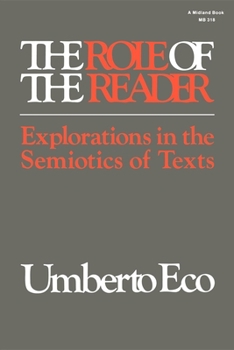The Role of the Reader: Explorations in the Semiotics of Texts
(Part of the Advances in Semiotics Series)
Select Format
Select Condition 
Book Overview
" . . . not merely interesting and novel, but also exceedingly provocative and heuristically fertile." --The Review of Metaphysics
" . . . essential reading for anyone interesting in . . . the new reader-centered forms of criticism." --Library Journal
In this erudite and imaginative book, Umberto Eco sets forth a dialectic between 'open' and 'closed' texts.
Format:Paperback
Language:English
ISBN:025320318X
ISBN13:9780253203182
Release Date:July 1979
Publisher:Indiana University Press (Ips)
Length:288 Pages
Weight:1.00 lbs.
Dimensions:0.7" x 6.0" x 9.0"
Grade Range:Postsecondary and higher
Customer Reviews
1 rating
Another contribution to semiotics from the master
Published by Thriftbooks.com User , 25 years ago
The Italian Umberto Eco is a literary critic, novelist, and semiotician (studying symbols and symbol systems). His introductory work to this fascinating field is "Semiotics and the Philosophy of Language" which is easier to start with. In "Theory of Semiotics" he presents his views. In his novel "The Name of the Rose" (1980) he brings the study of semiotics to fiction. In this book, Eco sets out to illustrate how the reader engages in constructing meaning when reading texts. Like Roland Barthes and others in the field of semiotics (which is the study of symbols in culture), Eco draws upon Ferdinand de Saussure (Course in General Linguistics) and Claude Levi-Strauss (Structural Anthropology). Yet Eco recognizes that meaning is not merely governed by structure, but also interactively constructed by the reader/interpreter, who often inserts or fills-in missing meaning to construct a coherent picture.Readers interested in questions of meaning, the philosophy of language, signs and symbols will find this a fascinating work. Although the subject matter is challenging, Eco's style is clear - he is a masterful writer.






